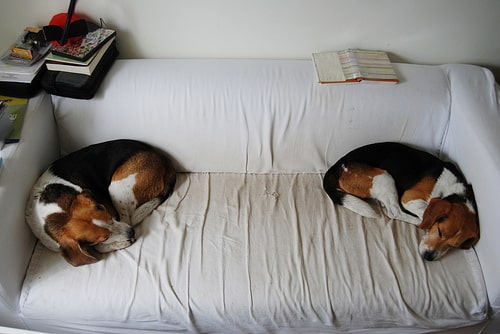A few weeks ago, I was invited by Katie Hood (Karen Pryor wrote about Katie in her recent letter about her trip to When Hounds Fly) to come watch a rehearsal of The Animal Show.
The Animal Show is a one-person play written and performed by Katie. In her own words (from her web site) it’s:
“A tale of caring for unwanted animals in Animal Rescue and the responsibility/hilarity that goes with it. Follow this fresh-faced (mostly klutzy) newcomer as she rescues bald eagles from the ocean, pulls 41 cats from one house, and falls in love with the man who saves a three-legged kitten.”
Katie draws from her own experiences in working in animal rescue – being on-call 24/7, enduring the hardships of helping mortally wounded animals, and perhaps most importantly, learning to cope with the public (that often don’t care one bit about the welfare of animals) and the bureaucracy (that often puts profit ahead of care). Katie structured her play around Doug Fakkema’s “Four Phases of Animal Rescue”, which describes the phases that someone working in animal rescue goes through (as follows):
Phase One: ZEALOTRY: Red hot and raring to go, we are out to change the world. We are high on life. We know that we can make a difference, that our efforts on behalf of animals will ease their plight.
Phase Two: ZOMEBIEHOOD: Our Phase One enthusiasm has turned sour; the bubble bursts and we crash and burn. We see the same people coming into the shelter with yet another litter—they haven’t heard our message. We continue to euthanize; there seems no end to it.
Phase Three: MISANTHROPY: Our Phase Two depression has turned outward and we’re mad as hell. Hopelessness turns to rage. We begin to hate people, any people and all people unless, like our coworkers, they dedicate their lives to animals the way we do.
Phase Four: “Big Picture Time”: Over time, though, the depression of Phase Two and the anger of Phase Three can become replaced with a new determination and understanding of what our mission really is. This is Phase Four—big picture time. We realize that we have been effective locally—and in some cases, regionally and even nationally. So we haven’t solved the problem (who could?), but we have made a difference for dozens, even hundreds and sometimes thousands of animals. We have changed the way others around us view animals. We begin to see our proper place in our own community, and we begin to see that we are most effective when we balance our work and out-of-work lives.
Katie’s performance is deeply personal – she travels through all of the four phases and her story reminds me of my own experiences in animal rescue.
I’ve volunteered and fostered at a handful of rescues – for sure, the rescue organizations led by those that are in Phase Four of their development of animal rescuers are by far the most efficient. They are realistic in their objectives. They respect and balance their need for personal time as well as their volunteers’ time. They never get angry at people and recognize that people make mistakes. Rescue organizations that have frustrated me are led by people that bounce around from Phase 1 to 3 depending on the time of day. They constantly lose volunteers, foster homes, and applicants. It’s hard to work with people that can go from boundless energy, to clinically depressed, to combative all in one day.
The Animal Show prompted me to reflect on a lot of things. I realized that although I have never been heavily involved in animal rescue, I’ve also gone through a similar process of transformation as a positive reinforcement dog trainer. It’s a journey that’s also deeply personal and at times I’ve done things that I’m embarrassed of. Here’s my journey, categorized into “The Four Phases of a Positive Reinforcement Trainer”.
Phase One: SMUG: You finally understand what a clicker is. Your dog is able to learn behaviors quickly and you think your dog is just the smartest thing ever and that you’re the most amazing trainer. Your dog walks beautifully on leash, comes when called, and knows a bunch of impressive tricks. You can’t help but feel like your dog is better than all the other dogs at the park, and you can’t help but feel schadenfreude when you see another owner struggling with their dog’s pulling, or their inability to collect their dog when it’s time to go home.
A personal story: Long before I even thought of becoming a professional dog trainer, someone at a Beagle rescue meetup saw me working with Duke with a clicker. He came to ask me about it. Rather than be a gracious representative of clicker training, I said something curt along the lines of “Well a clicker is something you need to get trained on how to use.” If by any chance you are reading this, man, I am sorry. I hope you went to Google that night and searched for “Clicker Training”. I could have just sent you to Clickertraining.com if I wasn’t so self-absorbed at the time.
Phase Two: DISCOURAGED: Time goes by and you’re no longer as caught up in your dog and your own training exploits. You start looking outward. What do you see? Dog after dog on the street in a prong collar. Another owner alpha-rolling and scruff shaking their puppy. A dog walker getting cross with one of their dogs and hanging it by the leash to “show him who’s boss”. You ask yourself, how could there be so many of them and so few of us? You can’t remember the last time you saw anyone teach their dog using food or toys at the park. And, oh great, everyone is taking their dog to that evil dog training school that advocates forced pinnings and leash corrections strong enough to send a dog off all four of their paws in the air. Everyone’s just beating on their dogs.
Another personal story: I stopped going to the more popular dog parks because it was just too much for me to watch. It bothered me whenever I saw dogs getting beat up. I only recently started going back.
Phase Three: ANGRY: You just can’t take it anymore. Anyone doing or teaching these methods that you find so repulsive must be stopped. Everywhere, anywhere! You spend countless hours on Facebook or other message boards arguing with Cesar Milan devotees about why “dominance” isn’t the reason why that dog is misbehaving. You give people walking their dogs on prong collars dirty looks. When someone asks you at a dinner party “Oh, you like dogs? Do you watch the Dog Whisperer?”, you read them the riot act, including the full AVSAB Position Statement on Dominance Theory.
Another personal story: While I didn’t spend a lot of time in this phase, I sometimes even now take a peep at different Facebook groups dedicated to hating on certain TV dog trainers.
Phase Four: “Big Picture Time”: After spending time being arrogant, depressed, and militant – sometimes all three in one day, you come to realize that the reason why you love positive reinforcement training is because you love dogs. If you love dogs, then your goal should be to help people love positive reinforcement training as well. You can’t accomplish that by being smug, depressed, or combative. When I understood this, I enrolled in the Karen Pryor Academy, with the intent of opening When Hounds Fly.
Thoughts about Phase Four:
- I catch more flies with honey than vinegar – there’s no point in vilifying the alpha roller, scruff shaker, or leash popper. They are just doing what they think is right. They do it because someone told them that it would help their dog, and in the end, they care enough about their dog to try. I’m ready for them when they want my help.
- Reinforce what you like, ignore what you don’t. There are many dog owners out there that carry a clicker in one hand and a prong collar in the other. Don’t vilify them either. Reinforce them for using a clicker. As they get better, the prong collar will collect dust. Attack them for having the prong collar and they’ll never want to get rid of it. Today, a new client came with their leash reactive dog on a prong collar. I made no mention of it, until forty minutes into our appointment, it came time to start training, at which point I let them try a Sense-ation harness, which they loved, and purchased on the spot.
- “If you can’t say something nice, don’t say nothin’ at all.”
- An hour spent blogging about clicker training will help hundreds, possibly thousands of people. An hour spent ranting about how evil (insert TV dog trainer’s name here) is doesn’t help anyone.
- I see so many Easywalk and Sense-ation harnesses nowadays. I also hear the sounds of faint clicks in the distance and delight to see my students training their dogs outside. Change starts one dog and owner at a time!
- I aspire to be here in Phase Four more often than not. Sometimes I bounce back to other phases, but I really try to think about the big picture and pull myself back… quickly!

